(Editor's [mom's] note: Tamara's interest in K's blog is partly what inspired him to go ahead and create a new blog post!)
Anywho, this is about the various creatures through time.
First off, we have the Cambrian period. In the Cambrian period, the first armored creatures thrived here, it had many trilobites, and the first top predator named Anomalocaris. And in the Cambrian the first human relative appeared.
Anomalocaris
(From walkingwithdinos.wikia.com)
Also in the Cambrian was Haikouichthys which was only about the size of your thumb.
Haikouichthys
(From www.twcenter.net )
The next period is the Ordovician. In the Ordovician, animals have gotten larger. However, back in the Cambrian and the Ordovician , the air is killer due to all the carbon dioxide. Luckily in the Silurian, which I am not going to be talking about in detail in this blog post, many creatures that are coral-like suck in this dangerous carbon dioxide and replace it with oxygen. Unfortunately, today in the present people have created factories and cars which are bring back that CO2 causing the world to warm up. That is the greenhouse effect. It was also very hot in the Ordovician and Cambrian periods. And in the Ordovician there were these cool vicious things named Megalograptus. It was also the first animal that can go on land.
Megalograptus
(From www.lifebeforethedinosaurs.com)
However a somewhat larger scorpion called Brontoscorpio could also do this. The stinger of Brontoscorpio was the size of a small light bulb.
Brontoscorpio
(From histoiredelavie.onlc.fr)
And yet there was even an even larger arthropod (arthropods being prehistoric spiders and spider like creatures) called Pterygotus. Pterygotus was a world wide creature that just didn't live in Antarctica. And Pterygotus' hunting strategy was hiding under the sand waiting for smaller animals to come near and then it would suddenly burst out capturing the prey with its claws. However this sea scorpion wasn't able to go on land due to its large weight.
Pterygotus Trying to Eat a Brontoscorpio
(From www.minecraftforum.net)
But the true top predator is Cameroceras. Cameroceras was a large squid like creature that had a large cone shaped shell on the back that it lives in. It could not actually go back into the shell. It just used it for unknown uses. At least I do not know.
Cameroceras
(From www.lifebeforethedinosaurs.com)
And now we will go forward into the Devonian period. The Devonian period had truly changed. The sea scorpions have grown smaller. There are still a few of the large ones, but mostly they just became their smaller counterparts. Our human ancestors have now finally made it onto land being named Hynerpeton. However Hynerpeton are amphibians. Its hard to believe that humans went from fish to amphibians to reptiles to mammals. I'll talk about the reptile thing a little later in this post. Any way. Hynerpeton could not be on land for too long because it had very thin skin that would quickly dry out. It would need to go back into the water for a while.
Hynerpeton
(From scratchpad.wikia.com)
But back in the water things are extremely dangerous. And it is especially dangerous due to the fact the the first sharks came in around this time. And the particular shark I am talking about is Stethacanthus. Stethacanthus wasn't exactly the largest shark, but it was large enough to chase around a Hynerpeton. And there was something very strange about this shark. The males had a very unusual dorsal find that looked like coral or something. But it wasn't exactly wasn't on the highest part of the underwater food chain.
Stethacanthus
(From www.bbc.co.uk)
I must mention, some plants have also evolved around this time and a little before this back in a period that I did not talk about called the Silurian. I didn't talk about the Silurian because most of the animals are similar to the ones in the Ordovician. The one that would be higher in the underwater food chain would have to be Hyneria. And it would definitely be large enough to eat a Stethacanthus. And yet even Hyneria isn't the top predator.
Hyneria
(From brianlean.wordpress.com)
The true true final predator is Dunkleosteus. Dunkleosteus was an enormous fish with lots of armor and plate-like teeth.
Dunkleosteus
(From www.bbc.co.uk)
And going further into the future to Carboniferous where there are enormous bugs and the arthropods have gotten big again. One of the largest insects was Meganeura, an enormous dragonfly. Meganeura had a 75 centimeter wing span which could also be said as 2.5-ft wing span.
Meganeura
(From walkingwithdinos.wikia.com)
And there was an enormous relative of the centipede named Arthropleura.
Arthropleura
(From jahandost.wordpress.com)
Meanwhile our human relative has turned into a reptile, but a very small one named Petrolacosaurus. Another this about Petrolacosaurus is that it is a mammal-like reptile, that is why we are related to it. As time went on the Petrolacosaurus got bigger and the bugs got smaller due to loss of oxygen.
Petrolacosaurus
(From walkingwithdinos.wikia.com)
The Petrolacosaurus evolved into a much larger version of itself and then as time went on they became small furry animals and then become monkey like creatures called Godinotia.
Godinotia
(From www.abc.net.au)
And then becoming a half ape-half man like creature called Australopithecus and then finally becoming the normal human being as we see ourselves today.
Australopithecus
(From www.bradshawfoundation.com
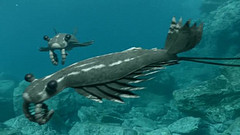
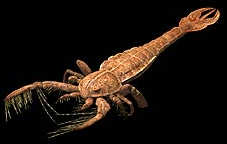
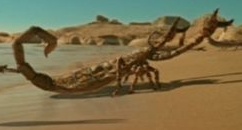








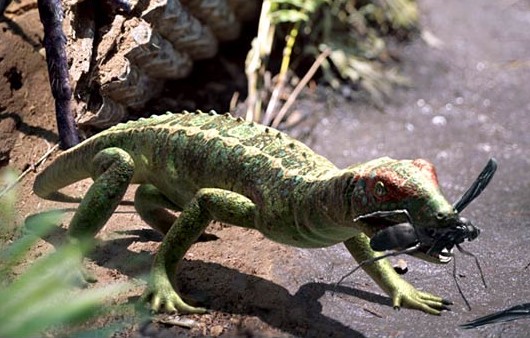

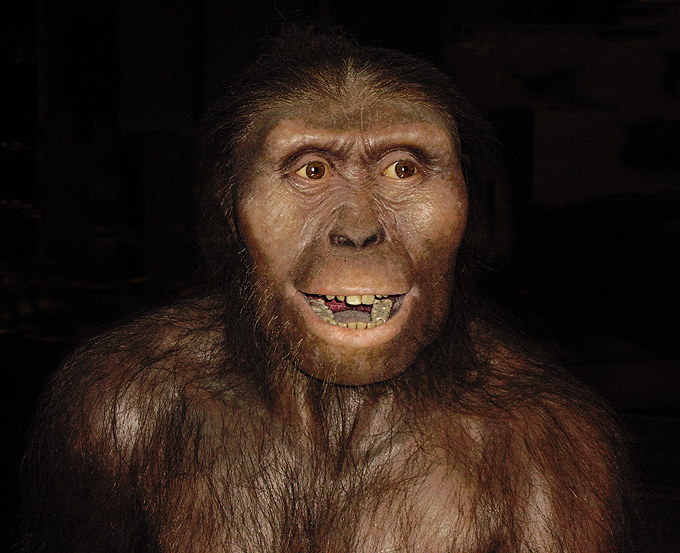
Cool - thanks for the new post!
ReplyDelete--Tia